Author: Jake Huolihan
Ask a group of homebrewers about the appropriate grain to use for a given style and you’re guaranteed to be met with claims that a quality lager requires Pilsner malt, British beers demand Maris Otter, and IPA is best made from standard Pale malt. Judging by the names alone, it seems obvious enough, though I’ll admit that prior to a couple significant xBmts demonstrating the impact of different grains, I’d adopted the rather flippant attitude that substitutions had little if any impact on the character of the finished beer.
Since I purchase all of my grains in bulk, making base malt substitutions is something I’ve had to do in order to complete a planned brew day, and while I’ve not been concerned swapping Pale malt for Pilsner, subbing in the opposite direction leaves me feeling a little more nervous. Reason being, Pilsner malt is made to produce beers that are crisp, relatively light on the palate, and generally clean with perhaps a touch of white bread character, which in mind works fine in more characterful styles; however, Pale malt is kilned slightly higher and imparts slightly richer flavors with less crispness. Curious to see if I could taste any differences myself, I decided to put it to the test!
Editor’s note: For the purposes of this article, Pale malt refers to what many call 2-row, which is actually the type of barley used to produce most malts; Pale malt differs from Pale Ale malt in that it is kilned slightly lighter.
| PURPOSE |
To investigate the differences between Rahr 2-Row Pale malt and Weyermann Pilsner malt when used in beers of otherwise similar recipes.
| METHODS |
I modeled the recipe for this xBmt after one of my go-to beers when I’m on the West Coast, Anchor California Lager, which the website lists as being made of Pale malt, Cluster hops, and their house yeast. I didn’t have any Cluster hops on hand, so I used Comet instead.
California Comet
Recipe Details
| Batch Size | Boil Time | IBU | SRM | Est. OG | Est. FG | ABV |
|---|---|---|---|---|---|---|
| 6 gal | 60 min | 42.2 IBUs | 6.1 SRM | 1.052 | 1.013 | 5.1 % |
| Actuals | 1.052 | 1.013 | 5.1 % | |||
Fermentables
| Name | Amount | % |
|---|---|---|
| Pale Malt OR Pilsner Malt | 12 lbs | 95.62 |
| Acid Malt | 8 oz | 3.98 |
| BlackPrinz | 0.8 oz | 0.4 |
Hops
| Name | Amount | Time | Use | Form | Alpha % |
|---|---|---|---|---|---|
| Comet | 20 g | 60 min | Boil | Pellet | 9.5 |
| Comet | 20 g | 30 min | Boil | Pellet | 9.5 |
| Comet | 15 g | 10 min | Boil | Pellet | 9.5 |
Notes
| Water Profile: Yellow Balanced in Bru’n Water |
Download
| Download this recipe's BeerXML file |
A couple days ahead of time, I made a large starter of Wyeast 2112 California Lager yeast that would later be split between 2 fermentors.
I filtered my RO water the night before brewing, adjusted it to my desired profile then weighed out the grains for each batch. The following morning, as the brewing liquor for the Pale malt batch was being heated, I milled the pre-measured grains.
To keep things less hectic, I started the Pilsner malt batch 20 minutes after the Pale malt batch; both were treated identically otherwise. Once strike temperature was reached, I incorporated the grists to achieve the same mash temperature in each batch.
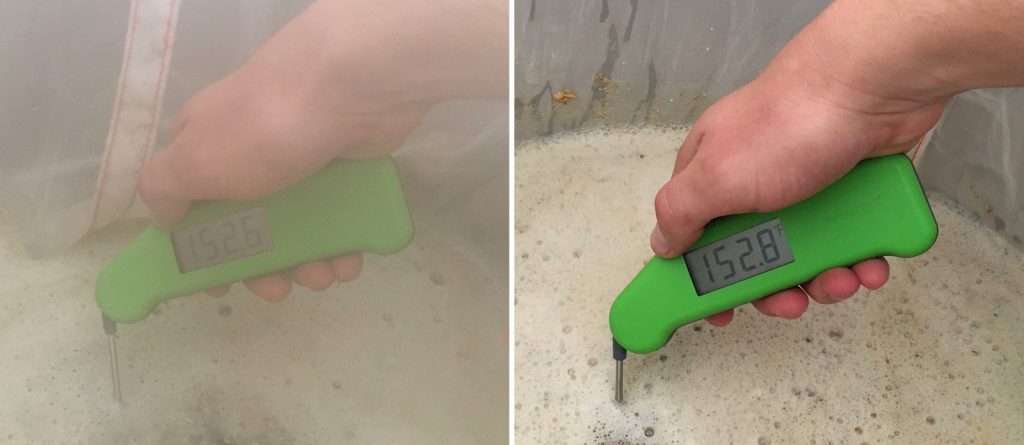
Both mashes were recirculated for the duration of their 60 minute saccharification rests. I pulled samples from each 15 minutes in to check the pH.
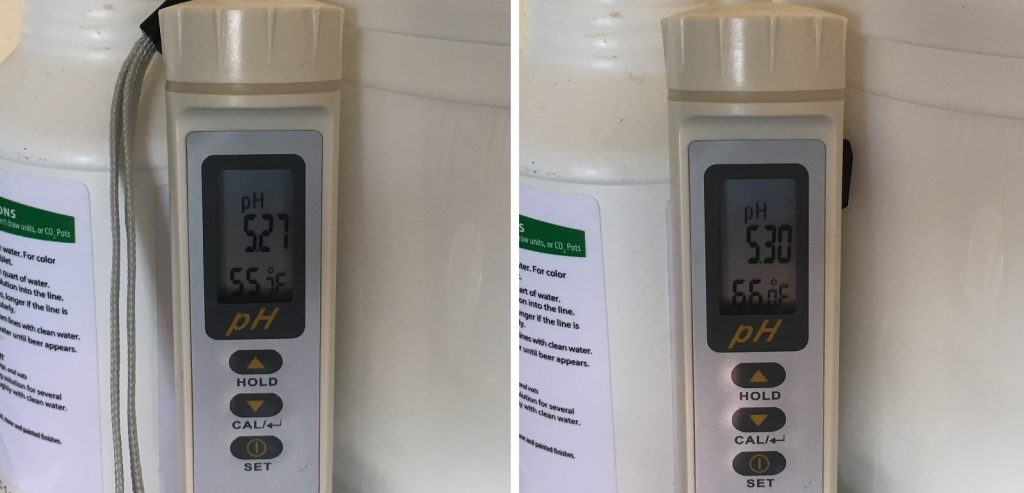
The grains were removed at the completion of each mash rest, the fabric filter being hoisted above the kettle and allowed to drain while the wort was heating.
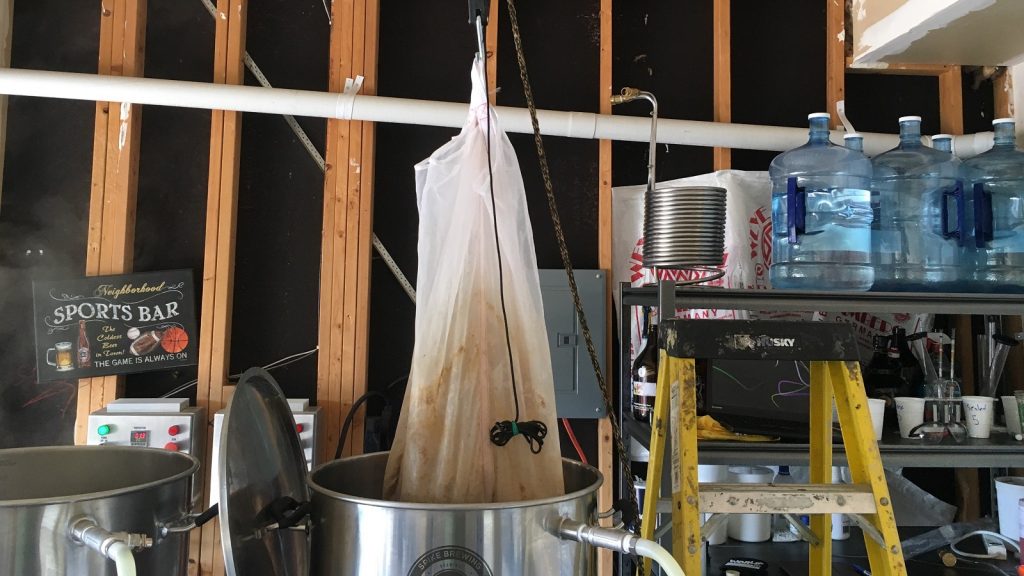
Each wort was then boiled for 60 minutes with hops added per the recipe.
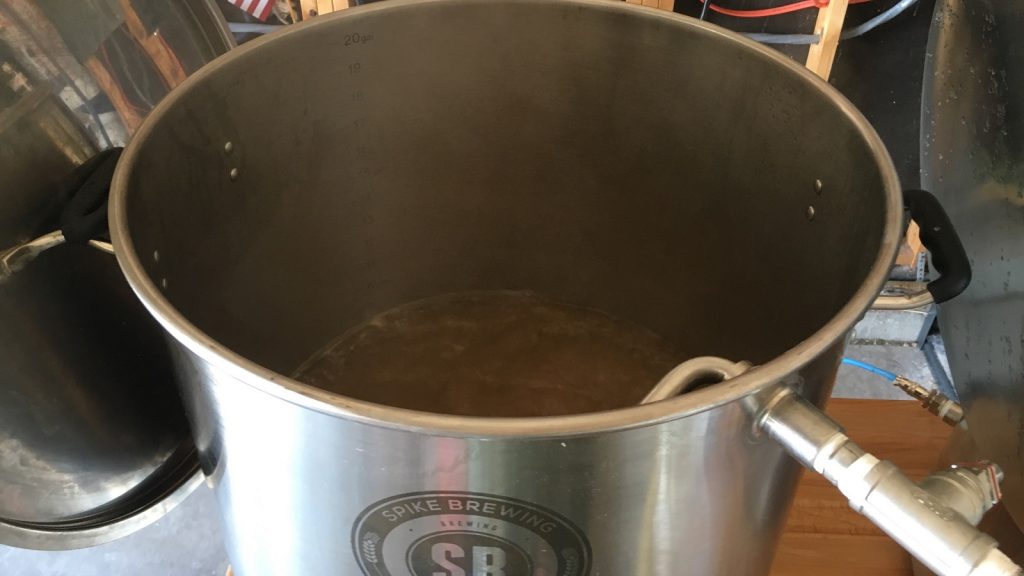
At the completion of the boil, I quickly chilled the worts to slightly warmer than my groundwater temperature.
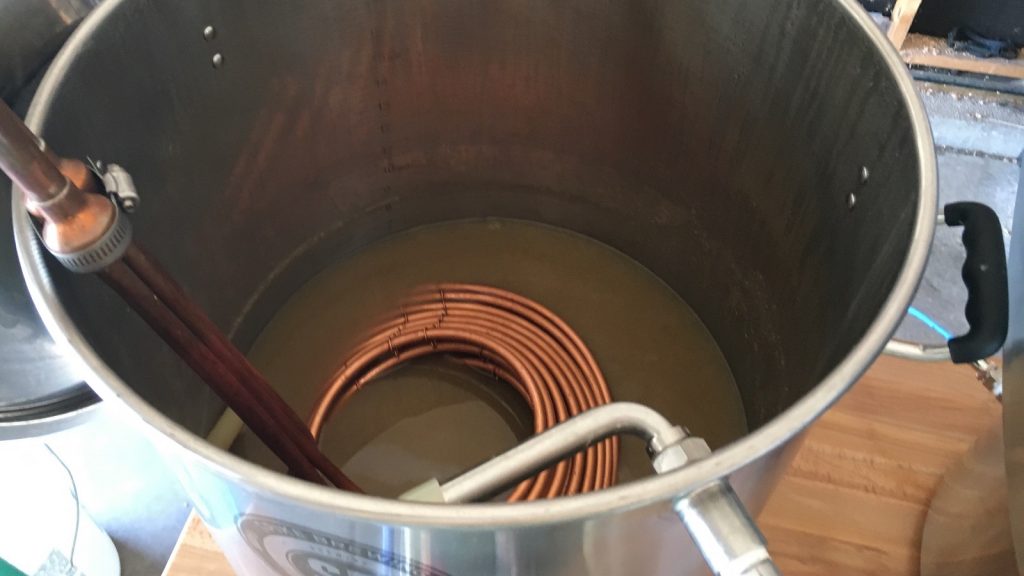
Hydrometer measurements showed both batches achieved the same 1.052 OG.
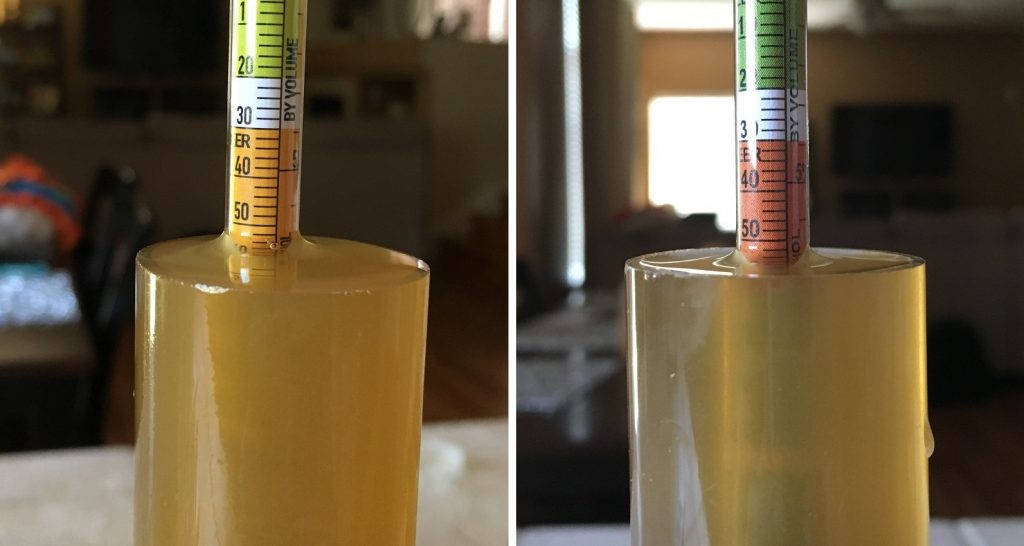
The wort made from Pale malt was noticeably darker than the Pilsner malt wort, which wasn’t unexpected given the known difference in kilning. I proceeded to rack the chilled wort to sanitized fermentors and placed them in a fermentation chamber set to my target fermentation temperature.
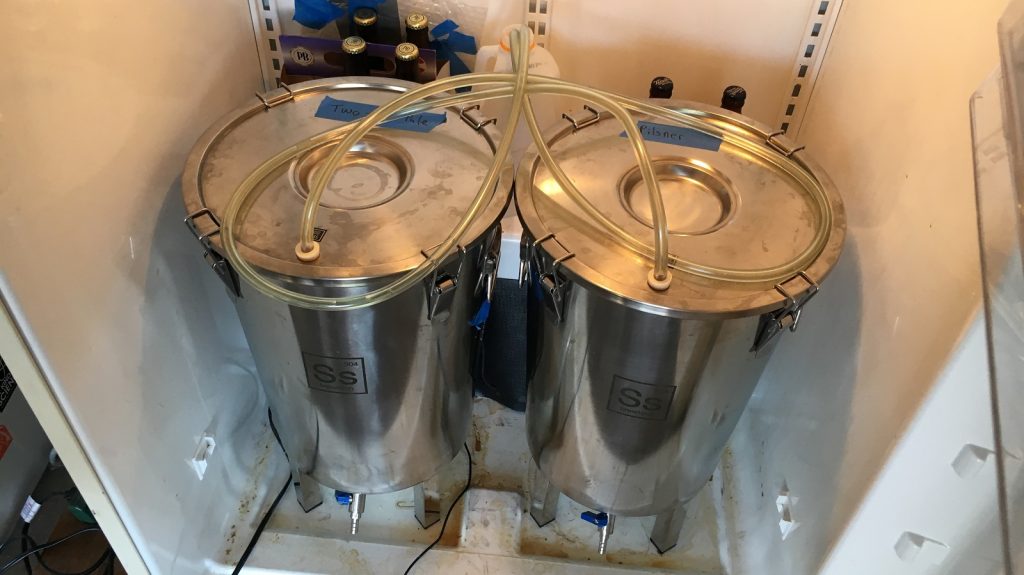
Both worts had stabilized at 58°F/14°C by the following morning, at which point I split the yeast starter equally between them then hit each with a 90 second dose of pure O2. Both beers were fermenting actively 24 hours later and continued down a similar path throughout fermentation. After 10 days, signs of activity absent, I took a hydrometer measurement that showed the Pale malt beer finished with a slightly lower FG than the Pilsner malt beer.
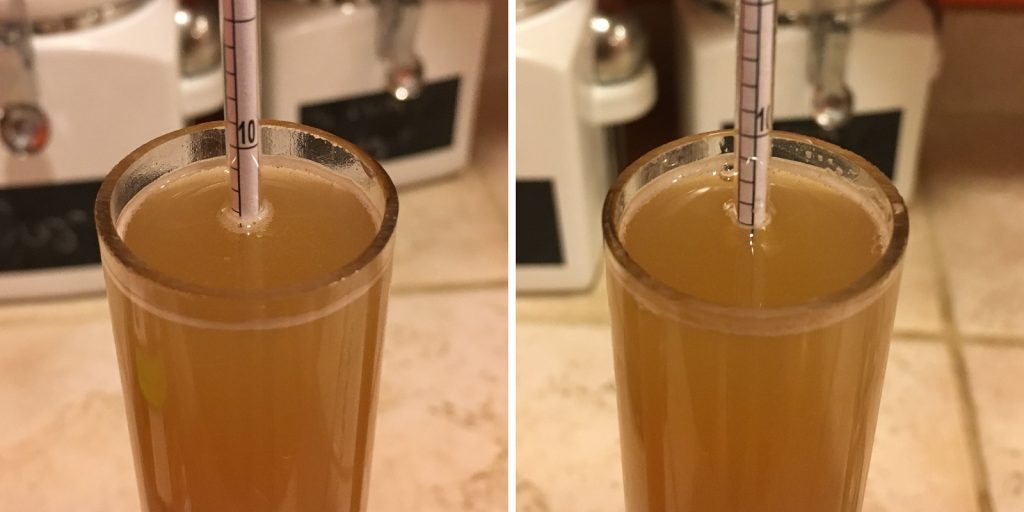
I bumped the temperature up and gave them 3 more days before measuring to confirm no change, after which the beers were cold crashed and kegged.
After adding gelatin to each keg, they were placed in my keezer and burst carbonated overnight before I reduced the gas to serving pressure. After a few days of cold conditioning, the beer were carbonated, clear, and ready to drink!
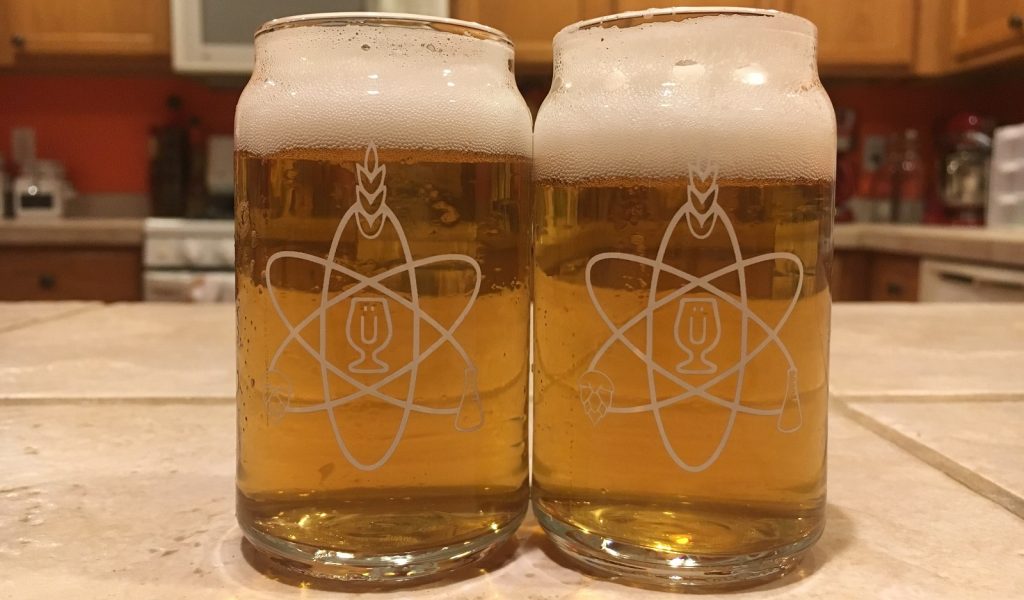
| RESULTS |
A total of 22 people of varying levels of experience participated in this xBmt. Each participant was served 2 samples of the beer made using Pale malt and 1 sample of the beer made using Pilsner malt then asked to identify the sample that was unique. In order to reach statistical significance at this sample size, 12 tasters (p<0.05) would have had to correctly identify the unique sample, though only 8 (p=0.46) did, indicating participants in this xBmt were unable to reliably distinguish a lager made Pale malt from one made with Pilsner malt.
My Impressions: These beers were much more difficult to discern than I imagined they’d be. Over multiple triangle test attempts, I was unable to consistently pick the odd beer out and lacked confidence with every guess. Both beers were clean with minimal malt character, which is to be expected from such a simple grain bill, and I was admittedly surprised by the lack of difference between them. Either way, I loved this beer and will definitely be brewing it again, likely with Pale malt since it’s a bit less expensive than Pilsner malt.
| DISCUSSION |
Arguably, the primary purpose of both Pale and Pilsner malts is to provide the bulk of a beer’s fermentables while creating a sort of blank slate upon which other flavors are built. Still, certain styles are known for being produced with a specific base malt– a Pilsner must be made with Pilsner malt, Pale Ale ought to be made with Pale malt. I’ll readily admit to being biased by these malt names such that I generally stuck to these conventions, which explains my surprise with the non-significant results of this xBmt. The fact is, Pilsner malt and Pale are objectively different, grown in separate parts of the world and kilned to different levels, yet tasters couldn’t tell apart a beer produced with one from a similar beer made with the other.
I’m reminded of an episode of The Session on The Brewing Network where, while sampling Tailgater Kölsch from Flat Tail Brewing, the brewcasters began talking about how it tasted like it was brewed using domestic Pale malt as a cheaper alternative to continental Pilsner malt. Then, on a subsequent show, someone from Flat Tail phoned in to inform the crew that the Kölsch had actually been made Weyermann Pilsner malt! Perception can be so fickle. As an aside, kudos to Flat Tail on their Kölsch, it’s my go-to when travelling through Oregon.
It’s true these results are but a single point of data that ought not be accepted as gospel, though based on my experience with both of these beers, my previous convictions about the differences between Pale and Pilsner malts have faded. I won’t be ditching the use of continental Pilsner malt altogether, but I’ll definitely be using more domestic Pale malt in styles I once believed required the former, especially if the biggest difference is a little more cash in my pocket.
If you have thoughts about this xBmt, please share them in the comments section below!
Support Brülosophy In Style!
All designs are available in various colors and sizes on Amazon!
Follow Brülosophy on:
FACEBOOK | TWITTER | INSTAGRAM
If you enjoy this stuff and feel compelled to support Brulosophy.com, please check out the Support Us page for details on how you can very easily do so. Thanks!


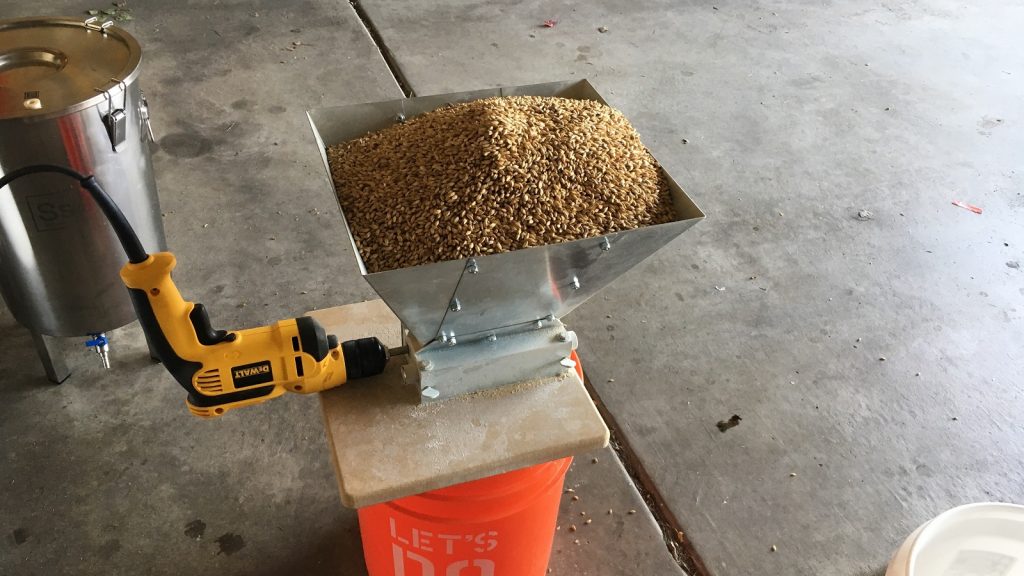
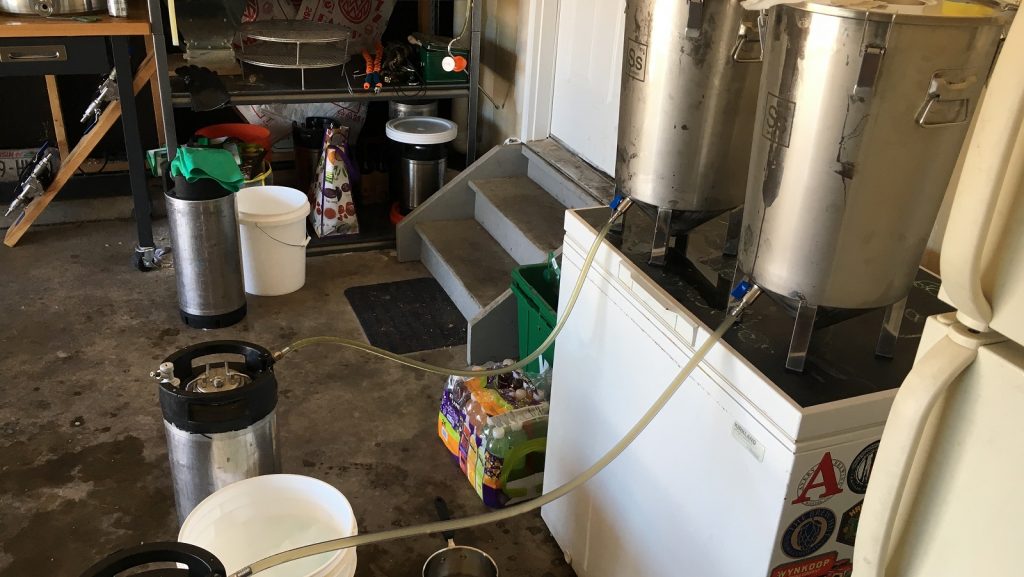










58 thoughts on “exBEERiment | Grain Comparison: Pale Malt (2-Row) vs. Pilsner Malt In A Pre-Prohibition Lager”
You need to fix your style sheet. If you have too many lines in this reply box, the “Post Comment” button gets hidden behind your WordPress Theme footer.
Why the Black prinz addition to the grain bill? I’ve seen a few times before and have always wondered what the goal of adding it is.
Thanks!
I’m wondering the same.. if you want to test the difference between the malts, you do just that. Pilsner with some Acid malt vs Pale with some Acid Malt. The blackprinz could have skewed the results. I recognize that this post is ~3 years old, but I’m wondering if the Blackprinz made a big enough impact even at 0.4%.
The blackprinz was a minuscule amount for color, my lord, it’s probably not making a flavor diff to effect the results
Black Prinz is the perfect malt to use for this test. It’s debittered and smooth. Less Acid malt may have diffrentiated the flavors a little more.We use 2% Acid Malt We’ve been testing batches with different grains and have used this Malt (Blackprinz) as the .5% grain. Using to much Acid Malt lowers the PH to much and you will not get ‘Proper’ test.
head retention
Thanks for the reply! Can you help me understand this one? Any sources you could share for how it helps head retention. Thanks!
One of my favorite recipes, which I brew each May, calls for Weyermann Bohemian Pils: http://braukaiser.com/wiki/index.php?title=Maibock
As I’m sure many of us do, I have multiple buckets filled with various malts. In my case, I have several filled with malt from a maltster that was a mixture of 2 and 6 row that had been prepared for a large commercial brewery (I live near Milwaukee, do the math).
One morning, in a rush to measure out the grains for the above recipe, I picked the wrong bucket. Instead of the bucket of imported Bohemian Pils, I grabbed the 2/6 row bucket. I realized my mistake only after having measured out all the grains into another bucket.
What to do. Dump it all and start over? Or just brew the damned thing up with the wrong base malt? What the hell, I decided to brew it. I could always dump it later if the BMC malt made it taste too BMC-ish.
But no, it was just as good as any other time I’ve brewed it with the far more expensive imported Bohemian Pils malt.
Wow, very interesting and surprising. I long ago convinced myself Bohemian pilsner malt has a distinctive malty tast that suits lager but now I’m wondering if that is just self-delusion working its magic.
The result makes me wonder if you’d find any difference in the following:
pilsner malt vs maris otter
pilsner malt with 10% munich vs 100% pilsner malt
pale malt with 20% vienna vs 100% pale malt
ditto biscuit malt, victory malt, etc.
I have always used 3-5% victory or biscuit malt to my pale malt when I want to mimics maris otter
My home brew club does blind tastings in a different style every month. Last month, a high scoring hefe was made with 0% wheat malt…
That sounds fun. Can you explain? I’d love to do similar blind tastings in my home brew club.
The basic process involves two elements: one person in the club acts as cellar master; the beers are served one at a time and each club member tastes and scores the beer based on BJCP guidelines before any discussion, so each score is independent of any other scorer’s opinion. After each beer, we discuss once everyone has given a score. The cellar master is the only one who knows the brewer. The only information the club members have is the required entry information per the BJCP.
Our club is pretty small and we usually have between 3 and 7 beers. Present club members can turn in their score sheets (we only do numbers, not full written feedback–you get that in discussion) along with a dollar to vote for the best beer. The brewer of the best, based on total points, gets half the money, the club gets the other half. There is also a Homebrewer of the Year competition
Oh, we do just a few related styles at each meeting. No competitions between RIS and kolsch.
I
lol! incredible
What is your mill gap set at? I use a Brewbag and was thinking about recirculating my mash. I usually mill at 0.026 and get good efficiency. Would I need to change anything if adding a pump?
Credit card width, which I believe is roughly .03
Same recipe but to compare that pale malt with 6 row malt will be interesting
Do people still use 6 row? Can’t say I’ve ever used it
Sure, for American lagers. Not sure of any noticeable difference though….
A lot of people still use 6-row and likely don’t even know. American crystal malts are often made with 6-row.
My LHBS said that Rahr will stop selling 6-row to shops.
I purchase a lot of local malt, and the maltsters treat it just like 2-row. They make pils, Munich, etc. it needs a closer mill setting (less than 0.030″).
In the pale form it has a nice grainy flavor. You will get more flavor using 6-row. Also more haze. Less efficient than 2-row in theoretical sugar yield, but the enzymes make up for that.
I often brew with 6 row. The beer tourned out pretty clear each time. I’m not sure about a huge difference in taste.
I love that the ever-so-slightly-more kilned Pale malt has an ever-so-slightly-lower pH compared to the Pils malt. I’m sure a good water chemistry calculator like Brun’ Water or Brewer’s Friend would’ve predicted this, but it’s nice to see this minor distinction show up in a well-controlled experiment.
Quick question on this point: I noticed the temp shown in each pH reading was a bit different (11 *), and wonder if you think that made any difference in pH? I use the same meter and I know it’s ATC, but I’ve read several places that ATC doesn’t quite work with pH meters the way it does with temp, for example. So do you think the readings here were affected by sample temp?
The pH reading is actually within my meters assumed error so I consider the two to be effectively the same. Though I did think was cool that it appeared to follow the science of kilning decreasing pH.
As to the temp function the meter was calibrated at 60F so I doubt ATC is having a huge effect here. I think when ppl talk about ATC not being accurate they are referring to measuring at like mash temps. But I could be wrong
That’s a pretty hoppy beer to be comparing the subtleties of a light malt.
So, maybe the take away, for some, can be for a slightly hoppy beer with a flick of Black Prince then… Pils vs 2 Row MAY not be able to be perceived by the average taster.
After realizing that every beer I’d made with Pilsner malt came out with a weird sweet flavor that I don’t like (not sure if this is DMS or just something my palate picks out) I quit using it all together and have been putting out better beers and never felt they were lacking something I could’ve gotten with Pils.
If you’re passing through Oregon, skip the beer and go right to the legal weed. Duh.
Tempting but I live in Colorado….
How the hell do you guys ‘burst carbonate’ and then cold condition for a handful of days, and then taste ANYthing except carbonic acid in your experiments? Am I doing something wrong? There seems to be a lot of conflicting anecdotal evidence about how to force carbonate, how injecting co2 changes the ph and flavor of the beer, and how long it takes for the ph and flavor to return to ‘normal’ (aka what it tasted like before force carbonation). For me, it takes like 10-12 days for the flavor to truly return to normal after burst carbonation (24-36 hours at 30-50 psi or something like that).
Totally off topic, but I see this in ALL of your exbeeriments, and it worries me because of how it could be muddling flavors and covering up significant results.. (or at least, in my experience it does).
I’m incredibly interested in this! Do you have any sources you particularly enjoy on the subject that you could share?
The method I use, and I think it’s pretty similar to what the crew uses, gives me pretty consistent results.
I go cold (35-38F) and 45 pounds overnight. I add the gelatin while I’m cold crashing. Then I lower it to about what I want the vols to be – so for an English Beer would probably be like 6 PSIG.
I just made a beer from grain to glass in 9 days. It included two days of dry hopping. It just won gold and scored in the mid-40s at a large competition in Cincinnati. British Golden Ale. Probably could have used another day or two to get super clear but it was clear enough. It was a large category and had some pretty nice beers in there. I had three judges scoring and all three seem to detect both the layered hops of English and American varieties, and the English malt character. Of course, I do believe sometimes people find those characteristics because of the categories they are judging, so who knows. Lol.
Was it a tad high in carbonation? Yeah I think so. But it certainly wasn’t a carbonic acid mess. I was venting it in the morning to make sure the keg wasn’t over carbonated.
To be clear, when I said “Am I doing something wrong?” that wasn’t a snarky/rhetorical question. I could easily be doing something wrong.
But.. yeah, I am constantly disappointed when I try to burst carbonate because of the ‘dirty snow’ flavor I get after injecting a lot of co2. The thing is, I rarely inject so much co2 that the beer actually ends up over-carbonated per se. In fact, I usually end up undershooting because it affects the flavor so much.
Your competition beer seems to debunk my theory that maybe I’m just super sensitive to recently-force-carbonated beer, and that maybe I am in fact doing something wrong. Its not.. that complicated though, so I’m really not sure what to change.
I read your comments. It’s a long shot but Maybe it’s your CO2 source or bottle. I’m not sure it’s even possible but maybe trying using a different CO2 supplier next time you fill your bottle. Might be worth a shot.
Burst-carbing, or doing anything else to the beers, wouldn’t affect the results as long as both carboys are given the same treatment. I suspect the 10-12 days it takes for your beer to “return to normal” is simply your beer reaching its optimum flavor peak, which all beers do. As for burst-carbing potentially changing the pH, that’s easy to test with a pH meter.
The only problem I have with that is.. I’ve had flat beer before, that I enjoyed. So I know what good flat beer tastes like (and my flat beer tastes good before carbonating. I basically take a hydro sample, chill it, and make sure it tastes perfect before force carbonation).
Yeah, the only problem with that is.. I know what flat beer tastes like, and I’ve enjoyed flat beer before, so I know what good flat beer tastes like, and I know what bad flat beer tastes like. I (as most people, im sure) take a hydro sample, and then chill it and taste it before force carbonating the batch, so yes its flat, but it doesn’t taste like it hasn’t ‘reached its optimum flavor peak’ yet.
The pH meter thing is something I still need to try. This is all anectodal so far. I’ve seen lots of people go ‘oh yeah, of course that weird flavor subsides’.. but then I see this entire series of exbeeriments, and very rarely do they wait 10-14 days before serving to participants. And the above 9 days grain to glass, winning gold in a competition thing is leaving me scratching my head even more than before.
I have never had that issue with carbonation. Interesting.
One question. If forced carbonating changes the pH of the beer, how could it return to its original pH level without removing the CO2?
Man it’s good to hear someone else say this, spot on mate. What’s your process? Iv even tasted it with set and forget method at serving pressure around 10
oops.
Hi,
I have major changes here at home using 2 row vs Pisner.
I suggest you try without the use of gelatin. (it may level them).
Thanks
Hi Jake. I’m interested in how this site takes the various and oft repeated “sacred truths” of brewing and actually questions and then tests their veracity. I happily buy whichever pale malt is on offer at my local shop and substitute wherever I want as a base malt in any recipe. I do the same with many kilned or crystal malts when I need to.
Maybe subtle differences in pale malt flavours can be detected in the beers of professional breweries but for the typical home brewer it can be a big enough struggle to product consistent brewing conditions/results.
I’m just happy when my beer tastes great.
Could you do this with a proper kolsch? Low I’m malt forwards and try to source the same maltster for both grains. That fermenitis German ale yeast comes to mind…
Also, I live in Washington and a lot of brewers are getting Skagit Valley malt…. I’m sure they’d live to work with you…
I hope to be in contact with them soon 🙂
Rahr 2-row and Weyermann Pils have very similar color ratings (Rahr = 1.6-2.1 SRM, Weyerman Pils 1.5-2.0).
German maltsters tend to (by tradition) call their palest malts “Pilsner” malts, the name doesn’t necessarily mean that there is a significant difference (from a malting process perspective) to an American maltster making a “pale 2-row” at a similar lovibond rating.
This experiment is really only useful for comparing Rahr 2-row to Weyermann Pils. Expanding that to insinuate that its a comparison of “Pilsner” vs “2-Row” malts in general is a mistake.
There’s a massive variation between continental maltsters and their “Pilsner” malts. There are several continental maltsters that have Pilsner malts that are lower (and even some that are higher) in lovibond rating than Rahr 2-row. I suspect you would have noticed a significant difference between Rahr 2-row and those.
Possibly the more useful comparison would be between Rahr 2-Row and Rahr’s own Pilsner malt, so you’d be comparing malts with a small but possibly significant lovibond rating delta.
You are correct that this does not cover all Pilsner v. “2-row” malts. Weyermann makes 6 different “Pilsner” malts, so perhaps this experiment should have had 7 different beers – Rahr 2-row and each one of Weyemann’s…
What this experiment does show is that if, on brew day, you find yourself short of German Pilsner, you can substitute American/Canadian 2-row, and few, if any, people will be able to tell the difference.
Great stuff! I don’t think I’ve seen this in the comments or other experiments, but I’d be interested in seeing you go the other way. Make a clean Helles or light hopped German Pils with US pale malt. I think that might be more telling as the taster is searching for the signature “pils” flavor against low hopping levels.
This is awesome. Writing a recipe for a split batch Pils and Saison. Only have Rahr 2row, and no fundage for the Pilz I would normally get. Was hoping it wouldn’t be too big of an issue. This reassured me that It won’t be a big enough difference to tell.
Jake
What are you using for fermention chamber.
Of late I use SS glycol and FTSS. This article is a fridge which I used for a few years
Cool , thanks
Thanks!!!
Ok I see this thread is from 2017 and I have recently been brewing an APA and Blonde. I replaced the usual Golden Promise with a British Lager malt when brewing my Blonde and I noticed a slightly more bitter/drier finish in the malt character whereas the Golden Promise had a more pronounced bread, biscuit finish. The xBmt above is for a lager/Pilsner brew though so an ale swapping the base malt may differ.
My 2 cents 👍🏼
When I first got a grain mill, the first bulk grain I bought was a big sack of 2 row pale. One morning I got up and thought, “hey, I’d like to brew today.” I had my pale malt, some Saaz hops, and some dry lager yeast. I figured I’d give it a whirl and now I make that beer all the damn time.
Another brilliant article. Thank you. I’ve recently started malting my own grain taking your approach by experimenting with single independent variables.
I always had the same perception that the different malts we buy were very distinct. However the malting schedule for pale differs only very slightly from pils. We’ve had success in making caramel malt and other speciality grains too. All from the same sack of (quality) horse feed. Thanks again.